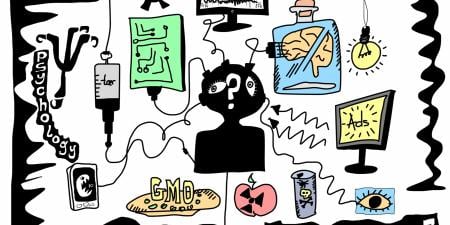Abstract
In this case and commentary, a patient’s request to be treated for depression without a stigmatizing diagnostic label of bipolar II disorder challenges a clinician’s obligation to provide a clinically and ethically appropriate diagnosis and safe treatment consistent with the patient’s family medical history. Sensitively recognizing and responding to patients’ concerns and values, even when they might conflict with the delivery of reasonable psychiatric care, is essential when gauging the appropriateness of such therapeutic practices. Furthermore, developing honest and open communication; recognizing that patients, like some psychiatric diagnoses, do not fit into discrete boundaries or cannot be categorized by a single label; and placing the patient at the center of care can all serve to resolve value conflicts, protect patient privacy, and promote accurate diagnostic and treatment practices.
Case
Tina, an 18-year-old college freshman, presents to a university mental health clinic complaining of symptoms of depression. She reports that she has been experiencing very low moods, crying spells, and a profound lack of energy and motivation, making it difficult to do even the most basic activities in her life. Moreover, the lack of motivation and problems with concentration have made it very difficult to keep up with her work, and Tina expresses the concern that she might fail out of school. She reports that one of her good friends from high school had something similar happen to her and responded well to sertraline, and that she was hoping that she could get a prescription for that.
A careful history and lab tests reveal that Tina’s symptoms are primarily isolated to the areas of mood, attention, motivation, and energy and that there is no medical or substance-induced cause of her symptoms. Tina reports no change in her appetite or sleep habits, no psychomotor agitation or retardation, no feelings of worthlessness or guilt, and no thoughts of suicide. When asked about the past, she says that for about a month after arriving at school she felt “fabulous.” She was getting As in all her classes and excelling as a member of the cross-country team. Although she had been very worried about meeting new friends when she started college, she states, “Then I realized that I didn’t have to worry about that at all, and that I was actually much more social than I thought. I made a ton of friends really fast.” Tina wasn’t sleeping as much as she had in high school at that time, but she thinks this was just “normal college stuff.” After about a month, she “settled in” and got on a more routine schedule. She does not express impulsivity, grandiosity, or psychosis. When asked about family members, she notes that both her father and older sister have bipolar disorder and quickly seems to want to separate her experience from theirs; she immediately adds, “I’m not like them at all. They’re crazy and irresponsible when they’re sick. I’ve never had anything like that.”
Despite this protestation, Tina’s physician, Dr. Kalif, suspects that Tina might be suffering from a depressive episode associated with bipolar II disorder. Tina is adamant that she is only concerned about her depression and wants to try a selective serotonin reuptake inhibitor (SSRI). Dr. Kalif convinces her that there is significant risk of a bad reaction to SSRIs given her personal and family history. Tina agrees to try lurasidone instead on the condition that Dr. Kalif agrees not to name bipolar disorder in her health record. Tina clarifies, “I’ve seen how people look at my dad and my sister based on those words, and I don’t want anyone to think I have that.”
Dr. Kalif can understand Tina’s wish not to have a diagnosis of bipolar disorder in her health record, particularly since Tina’s symptom history does not clearly include hypomania and Tina does not currently meet full criteria for bipolar disorder. But she suspects that Tina’s health insurance will not cover lurasidone for depression, and Tina could be upset about the resulting high cost. Dr. Kalif is also concerned that a prescription for lurasidone will look strange without a diagnosis of bipolar disorder recorded. Finally, she’s concerned that, at some point, if bipolar disorder does turn out to be the best description of Tina’s symptoms, she’ll have to betray Tina and name it officially in her health record.
Commentary
Other doctors may act upon the body, but the psychiatrist acts upon the soul. And it is the rich evaluative complexity of the self—the seat of evaluations, preferences, changes of mind, wishes, poetry, and passion—that sets the stage for the ambiguities of diagnosis.
John Sadler [1]
Mental disorder classification systems such as the Diagnostic and Statistical Manual of Mental Disorders (DSM) and the “International Statistical Classification of Diseases and Related Health Problems” (ICD) are designed to eliminate wide variations in diagnosis through the use of common terms and definitions, but without creating overly narrow diagnostic criteria that can exclude persons who are in need of treatment. The writers of the newest edition of the DSM—the DSM-5 [2]—recognize that the manifestations of mental disorders can map onto multiple overlapping criteria and that a “one-size-fits-all” approach to diagnosis and treatment is not optimal; accordingly, they developed dimensional metrics and spectra that combine many specific disorders into a single category (e.g., autism spectrum disorder). Despite efforts to create single-spectra categories, bipolar disorder (BD) and major depressive disorder (MDD), once captured in a single, mood disorders chapter of the DSM due to their similarities, are now separated into two different chapters in the newest edition [2].
Having classification standards, diagnostic methods, and labels or names to refer to particular phenomena provides health care professionals the tools to offer beneficial treatment, hopefully helping patients achieve vital goals through the reduction or elimination of pain and suffering [3]. The validity, reliability, and ethical appropriateness of a diagnosis depends on the nature, severity, and duration of the symptoms, the level of expected and actual benefits from treatment, clinical observations, and the self-reported unique needs and life story of the patient. However, even when applying DSM-5 criteria, mental health professionals might ignore the needs and values of patients, mislabel their symptoms, or misappropriate diagnostic terms, particularly when using classification systems in a cookbook fashion or assigning diagnostic labels to patients whose symptoms don’t actually fully meet criteria for a diagnosis. Additionally, any disease label has moral and social implications, which can include discrimination, dehumanization, disrespect of persons, and lack of access to vital resources and opportunities, which further perpetuate the social stigma of mental illness.
Turning to the case, Tina’s resistance to the diagnostic label of BD might stem from a lack of understanding and acceptance of her father and sister’s diagnoses and the overall stigma of mental illness. She’s observed and possibly been the subject of disrespect or discrimination as a member of a family with mental illness. Thus, before addressing Tina’s request that BD not be entered into her health record, it is critical for Dr. Kalif to address Tina’s concerns about the diagnostic label of BD, to try to better understand her relationships with her father and sister and the overall impact that mental illness has had on her family, and to provide education and support to help her gain a better understanding of her own mental health. Although Tina’s concerns about stigma associated with BD should not influence Dr. Kalif’s diagnostic decision, they should be discussed and reported in Dr. Kalif’s notes, particularly given their relevance to Tina’s story. To help reduce stigma experienced by their patients during clinical encounters, it is essential that practitioners remain as impartial and honest as possible in their diagnostic decisions and reporting, uninfluenced by patients’ fears, concerns, or demands, and at the same time that they recognize that psychiatric diagnoses are moving targets and that each patient has unique needs. As John Sadler writes,
Diagnosis does not just address the self; it also addresses a self engaged in the continuous modification and reinventing of itself. Who the patient “is” is under constant modification, and whichever mental disorder the person “has” is revised in concert with the self.… Psychiatric diagnosis, in turn, becomes a moving target, and mental disorders mutate within a complex biocultural interchange [1].
Sadler’s message is an important one to convey to persons with mental illness, who might feel as though their diagnoses define who they are as persons. Persons modify themselves in response to, or are modified by, a number of factors, including pharmaceutical and behavioral interventions, which contribute to their ability to gain insight about themselves in relation to others and to develop the necessary tools to manage, if not eliminate, mental health symptoms. In such cases, the psychiatric diagnosis may also change, revealing how mutable mental disorders really are. Thus, it is critical for health care professionals to provide continuity of comprehensive care to identify changes in the person in relation to the original diagnosis and to modify diagnoses and treatments based on those changes.
Clinically Appropriate Diagnosing
A trusting therapeutic relationship is essential, particularly when the diagnosis does not meet full diagnostic criteria and when a patient is wary about a diagnostic label. In Tina’s situation, her diagnosis neither fully meets the criteria of BD-II or (unipolar) MDD, yet she experiences the same type of depression specific to both [4]. Because BD shares similar symptoms with MDD, it is often difficult to distinguish the subtle differences between the two disorders. However, because Tina has experienced features of BD II, i.e., depression, and has a family history of BD, she is at increased risk of developing the disorder. Nevertheless, Dr. Kalif’s instinct is probably right that there is not enough evidence at this time to fully diagnose Tina with either BD-II or MDD, i.e., Tina currently experiences only 4 of a minimum of 5 of 9 required symptoms for MDD, and has not experienced a high episode of euphoria characteristic of BD-II.
Because Tina does not meet the full criteria for these disorders and the therapeutic relationship between her and Dr. Kalif is in its infancy, a provisional diagnosis of BD-II is an ethically and clinically appropriate alternative to simply labeling Tina with a disorder she might not have. Another option is for Dr. Kalif to diagnose Tina with “Other Specified Bipolar and Related Disorder,” which is designated in DSM-5 for those cases in which patients express too few symptoms to meet the BD-II criteria [5]. If future observations or patient self-reporting were to suggest BD-II (or even MDD), then the diagnosis could change; as mentioned earlier, diagnoses are moving targets. Furthermore, the mental health community recognizes that patients do not always meet the full diagnostic criteria for classified diagnoses and has, for the most part, captured this issue with the use of “provisional,” “not otherwise specified,” “other,” or “related” diagnoses. A provisional diagnosis promotes objective diagnosing and honest reporting, which is essential for providing effective treatments and advancing medical science and classification practices.
In recognizing that even a provisional diagnosis of BD-II or “Other Specified Bipolar and Related Disorder” may upset Tina, Dr. Kalif can further emphasize the fact all patients are different and may experience a range of symptoms of varying degrees; although Tina’s sister and father may be diagnosed with BD, their experiences and circumstances are unique. Such a conversation is important for reassuring her that while classifications of mental disorders are useful for research, identifying commonalities of etiology and symptoms, and access to care and resources (e.g., medications), they do not define patients. One is not “bipolar” but simply a person who experiences symptoms (e.g., depressive episodes) of the category BD-II, and each person diagnosed with BD is unique.
Ethically Appropriate Diagnosing and Sensitivity to the Patient
Dr. Kalif has an obligation to accurately report her findings in Tina’s health record, and neither patient demands nor insurance reimbursement concerns should influence her diagnosis, treatment, or reporting. By appropriately fulfilling such obligations, Dr. Kalif is preserving the integrity of diagnostic and treatment practices.
This is not to say that Dr. Kalif should ignore Tina’s plea to not report BD-II in her medical record, as her request is not only a catalyst for further discussion about her familial relationships and the identification of specific psychosocial issues in her life, but also expresses respect for and a deeper understanding of Tina’s social needs and values. Furthermore, if Dr. Kalif is more comfortable with a particular pharmaceutical intervention (lurasidone) and feels as though such treatment is more effective and safer than alternatives (SSRIs), intentionally misdiagnosing or assigning a diagnosis to a patient for purposes of accessing this treatment is dishonest, possibly fraudulent, and could have negative repercussions later (e.g., enhanced stigma, unnecessary economic burdens, and side effects, such as increased weight gain, that can be worse than the chief complaint).
A temporary alternative to reporting a diagnosis of BD-II (or even provisional BD-II or “Other Specified Bipolar and Related Disorder”) would be: (1) to report in her health record Tina’s family history of BD to call attention to the risks of using an SSRI and the justification for prescribing lurasidone and (2) to give Tina a provisional diagnosis of MDD, so long as the clinical presentation does not at this juncture favor BD. This approach might be the best way for Dr. Kalif to respond to Tina’s immediate clinical needs and abate her fears of being diagnosed with BD until she is able to develop a more long-standing, deeper, and more trusting therapeutic relationship in which to address these and related familial issues while also hopefully arriving, over time, at a more concrete diagnosis.
Protecting Tina’s Privacy
One possibility is that Tina would feel better about a recorded diagnosis if she knew her privacy was being protected as much as possible. Efforts to protect Tina’s privacy could involve Dr. Kalif keeping a separate record—not in Tina’s official health record—of her notes. A drawback to separate record keeping, which the American Psychiatric Association is strongly advocating against [6], is that such practices can reinforce stigma, promote confusion among health care professionals who might rely on the official health record as accurate and up-to-date, promote discontinuity of care, and contribute to harm (e.g., drug interactions).
Nevertheless, it is not uncommon, or unethical, for clinicians—in well-intentioned attempts to protect patients’ privacy—to keep sensitive, nonclinical patient information separate from the clinically relevant, or standard, health records, which are accessible to multiple health care providers and administrators who are relevant to the overall care of the patient. In this case, Tina’s life story, including her thoughts, feelings, and beliefs, captured through a psychotherapy session, could be contained in a nonclinical record that can only be seen by Dr. Kalif. Privacy regulations protect psychotherapy notes from being released to others without patient authorization; such protections are not afforded to any other medical records [5]. The primary health record, then, may contain limited but relevant mental health information, such as diagnoses, treatments, and family history. Thus, in this case, a provisional diagnosis of MDD, if appropriate, along with a description of relevant family history, should be listed on the primary health record—accessible for purposes of coding and billing, health care insurance coverage, determining if existing or future physical conditions and treatments might affect or be affected by Tina’s mental health status, and potentially for chart reviews in research. Tina’s privacy, to an extent, is protected, and appropriate safeguards are in place to prevent potential harm. Tina may pay for care and resources out of pocket if she is financially able to do so, thus limiting the number and type of entities that have access to her primary health record (e.g., insurance companies).
Such discussions between Dr. Kalif and Tina are significant to Tina’s overall care, as are conversations about how well the lurasidone is working, her relationships with friends and family, and the future possibility of a confirmed diagnosis of BD-II. These therapeutic conversations—along with accurate, up-to-date health records (including a separate, private record to capture Dr. Kalif’s psychotherapy notes) that accommodate evolutions in diagnostic process and a patient’s access to treatment and care—can best help Tina achieve her goals, improve her quality of life, and avoid unnecessary harm.
Conclusion
In conclusion, sensitivity to Tina’s concerns about BD is important for ethical considerations, but, ultimately, Dr. Kalif should base her diagnosis and treatment plan on clinical knowledge and professional integrity rather than her patient’s wishes, which may be generated by fear, misunderstanding, and a lack of proper support and guidance.
References
-
Sadler JZ. Diagnosis/Antidiagnosis. In: Radden J, ed. The Philosophy of Psychiatry: A Companion. Oxford, UK: Oxford University Press; 2004:165.
-
American Psychiatric Association. Diagnostic and Statistical Manual of Mental Disorders. 5th ed. Arlington, VA: American Psychiatric Association Publishing; 2013.
-
Aultman J. Mental illness: concept of. In: ten Have H, ed. Encyclopedia of Global Bioethics. Dordrecht, The Netherlands: Springer International Publishing; 2015:1-10.
-
According to the DSM-5, for a BD-I diagnosis, it is necessary to meet criteria for a manic episode, which may have been preceded by, and may be followed by, a hypomanic or major depressive episode. On page 124 of the DSM-5, a manic episode is defined as a “distinct period of abnormally and persistently elevated, expansive, or irritable mood and abnormally and persistently increased goal-directed activity or energy, lasting at least 1 week and present most of the day, nearly every day (or any duration if hospitalization is necessary).” Manic episodes cause social or occupational functioning impairment and are not attributed to substance abuse. Under the DSM-5, BD-II includes a hypomania episode (high episodes of euphoria and low episodes of depression), has one or more major depressive episodes and at least one hypomania episode that must last for at least four days. Hypomania is an elevated mood that is not as elevated as mania and is not easily observable or reportable given that it does not contain psychosis or life-threatening consequences.
- Appelbaum PS. Privacy in psychiatric treatment: threats and responses. Am J Psychiatry. 2002;159(11):1809-1818.
-
Dolan PL. Do missing mental health notes undermine EHRS? American Medical News. February 11, 2013. http://www.amednews.com/article/20130211/profession/130219979/4/. Accessed May 3, 2016.



